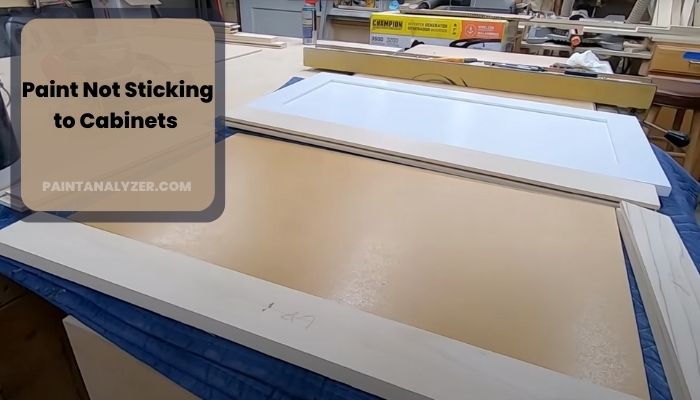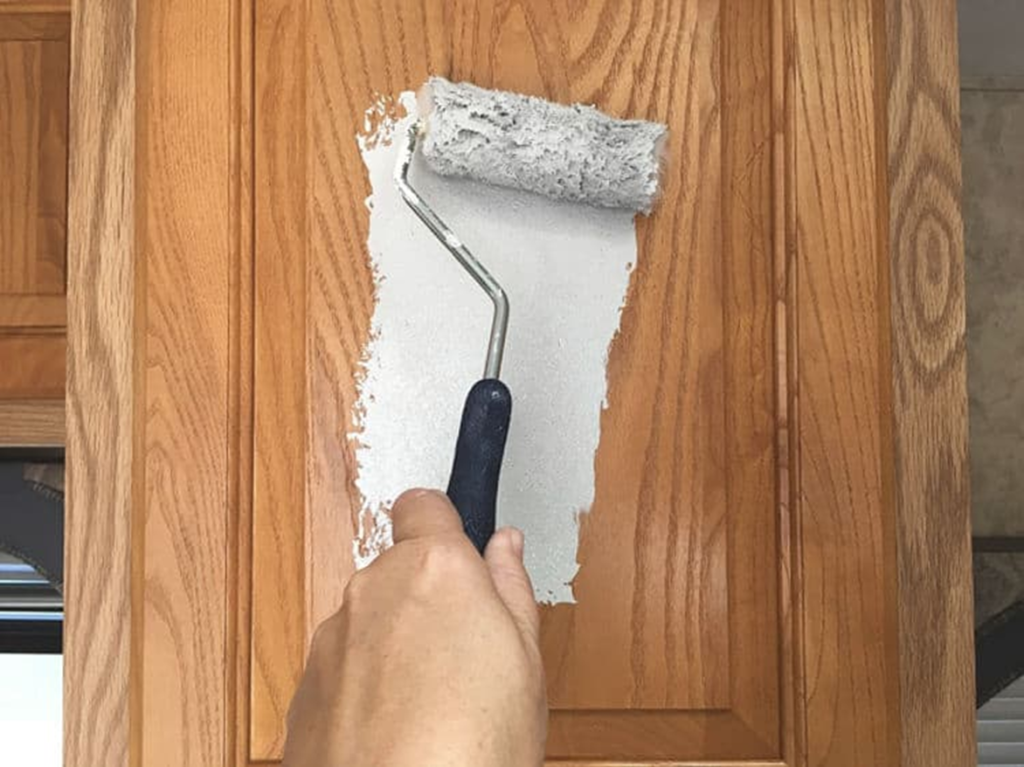When it comes to painting your kitchen cabinets can be a daunting task. After all, it’s a big investment and one that you don’t want to mess up! But what happens when you’ve done the hard work, and the paint just isn’t sticking to the cabinets?
It’s a common problem, and that happens for many reasons. The common culprits are dust, oil, and even moisture. However, if you properly prepare the surface, you can be sure that the paint will stick, and you won’t have to start all over again.
If you are one of those people who are struggling to get the paint to stick, keep reading to find out why your paint is not sticking to the cabinets and how you can get it to stick.

Why Your Paint Is Not Sticking To The Cabinets?
It is frustrating when your paint job isn’t sticking to your cabinets. There are several reasons why this could be happening, and understanding those reasons can help you fix the problem. Here are a few of the most common reasons why your paint isn’t sticking to your cabinets.
Poor Surface Preparation
Before you start painting your cabinets, it is important to make sure that the surface is properly prepared. This means sanding the surface, removing any dirt or debris, and ensuring that the surface is smooth and free of any imperfections. If you skip this step, the paint won’t have anything to adhere to and will end up peeling off.
Wrong Primer
Primer is essential in helping your paint stick to the cabinets. However, it is important to choose the right primer for the job. If you are using water-based paint, make sure to use a water-based primer. Similarly, if you are using an oil-based paint, use an oil-based primer. If you don’t use the right primer, the paint may not stick.
Poor Quality Paint
If you are using low-quality paint, it will be difficult for it to adhere to the cabinets. Make sure that you are using high-quality paint that is designed for cabinets. This will ensure the best results and will help your paint last longer.
Glossy Surface
If the surface of the cabinets is too glossy, the paint won’t be able to adhere properly. To fix this problem, you will need to sand the surface to make it more porous and then use a primer to help the paint stick.
Improper Paint Preparation
It is important to mix the paint properly before you start painting. If the paint is too thick, it won’t be able to adhere to the cabinets. Make sure that you mix the paint according to the instructions and that you are using the right brush or roller for the job.
Temperature and Humidity
Temperature and humidity can also play a role in why your paint isn’t sticking to your cabinets. If it is too humid or too cold, the paint may not adhere properly. Make sure to paint your cabinets when the temperature and humidity are ideal.
If you are having trouble getting your paint to stick to your cabinets, it is important to identify the problem and take the necessary steps to fix it. With the right preparation and the right paint, you should be able to get a beautiful and long-lasting paint job on your cabinets.

Credit: thepalettemuse
What Can I Do to Ensure Paint Sticks to Cabinets Instead of Staining Them?
When looking to paint or stain kitchen cabinets, the key is proper preparation. Start by thoroughly cleaning the cabinets to remove any grease or grime. Sand the surfaces to create a rough texture for the paint or stain to adhere to. Finally, apply a quality primer before painting or staining.
Paint Is Not Adhering? Here Is The Step By Step Solution!
If you’re about to start a painting project and your paint is not adhering, you’re probably feeling a bit frustrated. Don’t worry, though – there are several steps you can take to fix the issue and get your project back on track. Here is a step-by-step guide to help you get started.
Step 1: Prepare The Surface
Before you apply any paint, make sure the surface is clean, dry, and free of dirt, dust, or any other debris. You may need to sand the area or use a degreaser to remove any oily residue.
Step 2: Sand Properly
Dirt and dust are common culprits that can create a barrier, preventing the paint from properly sticking to the surface. Before you begin painting, it is important to ensure that the surface is adequately sanded to ensure proper adhesion of the paint. Sanding the surface will remove any debris and rough up the surface, creating a better surface for the paint to adhere to.
Step 3: Prime The Surface
Priming the surface is essential for ensuring that the paint adheres properly. Use a quality primer that is specifically designed for the type of surface you’re painting. This will help the paint to stick and provide a better base for the finish.
Step 4: Use Quality Paint
Using quality paint is key to making sure the paint adheres to the surface. When choosing a paint, pay attention to the manufacturer’s recommendations for the type of surface you’re painting.
Step 5: Use The Right Tools
Using the right tools is also important for ensuring the paint adheres properly. Make sure you’re using a brush or roller that is designed for the type of paint you’re using.
Step 6: Apply The Paint Properly
When applying the paint, make sure you’re doing it in thin, even coats. Allow each coat to dry completely before applying the next. Also, make sure to avoid “over-brushing” or “over-rolling” the paint, which can cause it to not adhere properly.
Step 7: Clean Up
Once your project is complete, make sure you clean up any paint that may have gotten on surfaces that you don’t want to be painted. This will help to ensure that the paint will not damage any surfaces to which it did not adhere.
Following these steps should help you get your painting project back on track and ensure that the paint adheres properly. Just remember to be patient and follow the manufacturer’s instructions for the best results. Good luck!
Avoid These Mistakes While Painting Your Cabinets
Conclusion
There are several reasons why paint may not be sticking to your cabinets. It could be due to improper surface preparation, incorrect paint choice, or inadequate application techniques. To ensure your cabinets are correctly painted, it is best to begin by cleaning the cabinet surfaces and investing in quality materials. Be sure to use the right primer and paint, and follow the manufacturer’s instructions for the best results.
Additionally, be sure to avoid common mistakes such as not sanding the surface, not using an appropriate primer, or applying too thick of a coat. With these steps, your cabinets will look good as new in no time!
